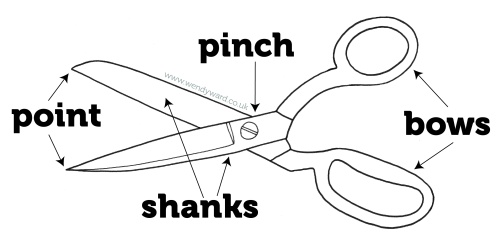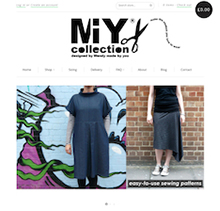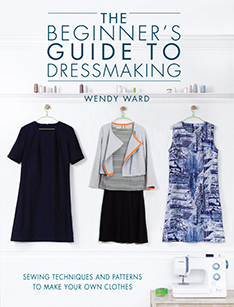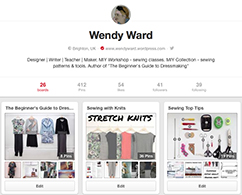My column for this month’s Love Sewing magazine is all about scissors. Not like me to be going on about scissors is it?!
Here’s a little edited version of the column:
Anatomy of a pair of scissors.
Scissors or shears?
What is the difference between scissors and shears? A good question as fabric cutting scissors often appear to be interchangeably called dressmaking, fabric or tailor’s shears or scissors. Well, apparently when scissor blades are longer than 15cm or 6 inches, they become shears.
Commonly used scissors and shears for dressmaking:
FABRIC SHEARS
Have handles set at an angle to make it easier to ensure the fabric is lifted as little as possible from the cutting surface. The lower handle is larger to accommodate your fingers and handles are often molded to be a more comfortable fit. They come in different sizes, which refers to the length of blades. I like to work with 10” shears, but 8” are also useful and probably easier for beginner dressmakers.
PAPER SCISSORS
Make sure you have a reasonable sized pair of scissors for cutting paper patterns. I prefer to use a similar style of scissors to my fabric ones, ie. angled handles and long blades. Cheap poor quality fabric shears actually make great paper scissors!
THREAD SNIPS
For snipping thread ends when working on your machine, these specially shaped thread snips fit onto just your 2nd or 3rd finger and sit inside your hand to give you more control. They can take a bit of getting used to if you haven’t used them before, but many sewers love them and won’t use anything else.
SMALL SCISSORS
An alternative to snips which I tend to prefer. Choose a pair with large bows (handles) for comfort and make sure they have super sharp points. Keep them for snipping threads when working on your machine, for unpicking and for removing tacking.
BUTTONHOLE SCISSORS
Unusual shaped scissors, with short blades and often with an adjustable screw between the handles. The screw is adjusted so that the scissors can only cut the length of your buttonhole! Much more accurate and tidier than cutting buttonholes with a seam ripper.
APPLIQUÉ SCISSORS
Another pair of unusually shaped scissors, I honestly don’t know what I did before I got my pair they are just so useful. Interchangeably also referred to as duck-billed or napping scissors. In dressmaking I use them most for layering seams. That wide blade on the bottom and the angled up handles allows you to layer seams with no danger of accidentally cutting through the fabric underneath. They are also useful for cutting into reverse appliqué.
Which ones you really need and which ones are “nice to haves”:
As a bare minimum aim to have a pair of each of the following in your sewing tool kit. Save up and buy quality and you will only need to buy them once.
- Fabric shears (at least 8 inch / 20cm)
- Small scissors OR snips
- Paper sicssors (a cheap pair of fabric shears are best, not a 50p pair of tiny craft scissors!)
As you start to do more sewing, you will find these useful so invest in them as and when you can (or stick them on your Christmas list!), but again, quality only and they’ll last you a lifetime of sewing…..
- Appliqué scissors
- Buttonhole scissors
A big thanks to Nick Wright of Ernest Wright & Son (one of the remaining Sheffield scissor makers) who is responsible for a lot of my scissor knowledge!



























Pingback: Top 20 Beginner Sewing Questions (& Answers!) | Wendy Ward
Do you have any advice on sharpening scissors?
LikeLike
Ask your hairdresser where they get their scissors sharpened and go to the same place.
LikeLike